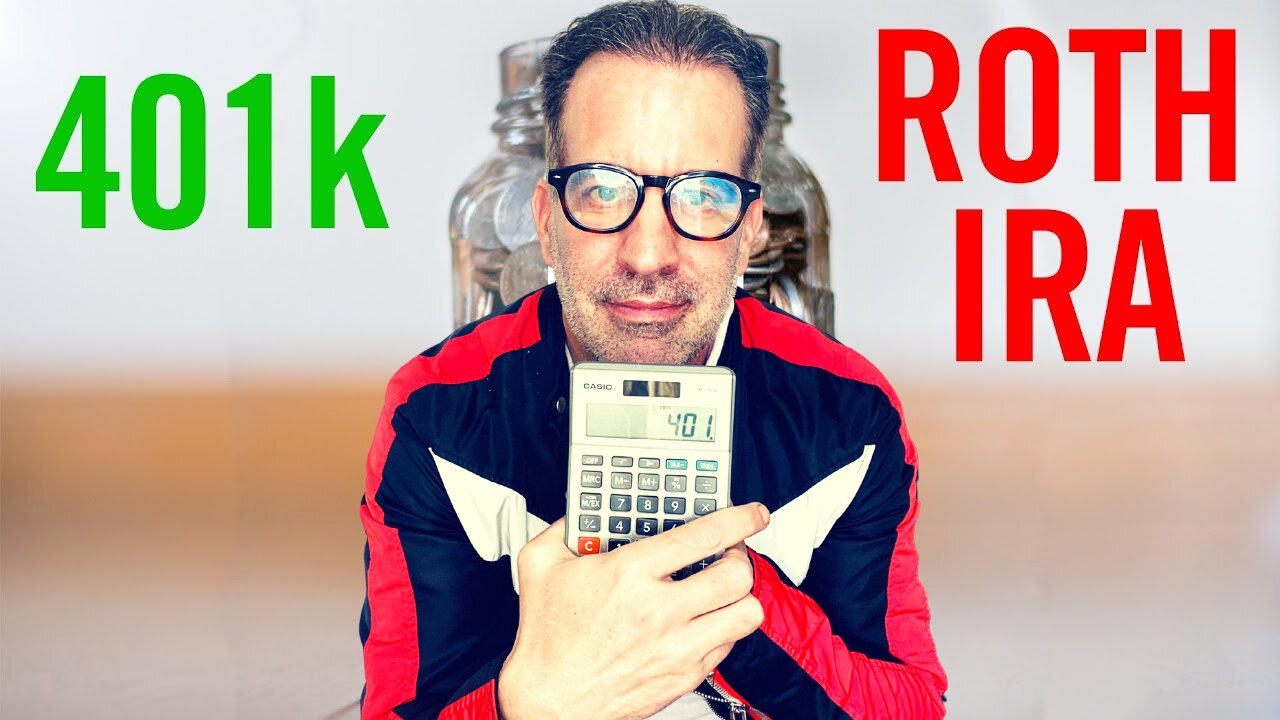Premium Only Content

401K VS Roth IRA (YOU THINK YOUR GOING TO GET RICH? THINK AGAIN!)
EXAMPLE: CONSIDERS GOOD RATE OF RETURN
For a high-income earner, a traditional could be the better option.
In the United States, a 401(k) plan is an employer-sponsored defined-contribution pension account defined in subsection 401(k) of the Internal Revenue Code.[1] Employee funding comes directly off their paycheck and may be matched by the employer. There are two types: traditional and Roth 401(k). For Roth accounts, contributions and withdrawals have no impact on income tax. For traditional accounts, contributions may be deducted from taxable income, and withdrawals are added to taxable income. There are limits to contributions,[2] rules governing withdrawals, and possible penalties.
The benefit of the Roth account is from tax-free capital gains. The net benefit of the traditional account is the sum of a possible bonus (or penalty) from withdrawals at tax rates lower (or higher) than at contribution, and the impact on qualification for other income-tested programs from contributions and withdrawals reducing and adding to taxable income, minus the consequences of capital gains being taxed at regular income rates.
Before 1974, a few U.S. employers had been giving their staff the option of receiving cash in lieu of an employer-paid contribution to their tax-qualified retirement plan accounts. The U.S. Congress banned new plans of this type in 1974, pending further study. After that study was completed, Congress reauthorized such plans, provided they satisfied certain special requirements. Congress did this by enacting Internal Revenue Code Section 401(k) as part of the Revenue Act. This occurred on November 6, 1978.
Traditional
Income taxes on pre-tax contributions and investment earnings in the form of interest and dividends are tax-deferred. The ability to defer income taxes to a period where one's tax rates may be lower is a potential benefit of the 401(k) plan. The ability to defer income taxes has no benefit when the participant is subject to the same tax rates in retirement as when the original contributions were made or interest and dividends earned. Earnings from investments in a 401(k) account in the form of capital gains are not subject to capital gains taxes. This ability to avoid this second level of tax is a primary benefit of the 401(k) plan. Relative to investing outside of 401(k) plans, more income tax is paid but less taxes are paid overall with the 401(k) due to the ability to avoid taxes on capital gains.
For pre-tax contributions, the employee does not pay federal income tax on the amount of current income he or she defers to a 401(k) account but does still pay the total 7.65% payroll taxes (social security and medicare). For example, a worker who otherwise earns $50,000 in a particular year and defers $3,000 into a 401(k) account that year only reports $47,000 in income on that year's tax return. Currently, this would represent a near-term $660 saving in taxes for a single worker, assuming the worker remained in the 22% marginal tax bracket and there were no other adjustments (like deductions). The employee ultimately pays taxes on the money as he or she withdraws the funds, generally during retirement. The character of any gains (including tax-favored capital gains) is transformed into "ordinary income" at the time the money is withdrawn.
If the employee made after-tax contributions to the 401(k) account, these amounts are commingled with the pre-tax funds and simply add to the 401(k) basis. When distributions are made the taxable portion of the distribution will be calculated as the ratio of the after-tax contributions to the total 401(k) basis. The remainder of the distribution is tax-free and not included in gross income for the year.
Roth
For accumulated after-tax contributions and earnings in a designated Roth account (Roth 401(k)), "qualified distributions" can be made tax-free. To qualify, distributions must be made more than 5 years after the first designated Roth contributions and not before the year in which the account owner turns age 59+1⁄2, unless an exception applies as detailed in IRS code section 72(t). In the case of designated Roth contributions, the contributions being made on an after-tax basis means that the taxable income in the year of contribution is not decreased as it is with pre-tax contributions. Roth contributions are irrevocable and cannot be converted to pre-tax contributions at a later date. (In contrast to Roth individual retirement accounts (IRAs), where Roth contributions may be recharacterized as pre-tax contributions.) Administratively, Roth contributions must be made to a separate account, and records must be kept that distinguish the amount of contribution and the corresponding earnings that are to receive Roth treatment.
Unlike the Roth IRA, there is no upper-income limit capping eligibility for Roth 401(k) contributions. Individuals who find themselves disqualified from a Roth IRA may contribute to their Roth 401(k).
-
 13:48
13:48
NONCONFORMING-CONFORMIST
1 year ago $0.01 earnedThe World As We Currently Know Will Change Forever
351 -
 17:03
17:03
Nicholas Bowling
18 hours ago $0.72 earned"Celebrity" Tells Street Preacher His Dad's in the ILLUMINATI
10.7K2 -
 LIVE
LIVE
BEK TV
21 hours agoTrent Loos in the Morning - 7/30/2025
157 watching -
 4:10
4:10
Blackstone Griddles
13 hours agoCajun Dogs with Bruce Mitchell
10.5K1 -
 29:38
29:38
Uncommon Sense In Current Times
15 hours ago $0.46 earnedIs Doubt a Sin? Wrestling with Faith & Belief (Part 1) | Dr. Randal Rauser
18.7K5 -
 8:29
8:29
The Art of Improvement
21 hours ago $0.35 earned4 Strategies To Accelerate Your Personal Growth By 200%
14.5K1 -
 LIVE
LIVE
The Bubba Army
22 hours agoTrump Pardoning Diddy? - Bubba the Love Sponge® Show | 7/30/25
1,772 watching -
 10:53
10:53
Nikko Ortiz
1 day agoWORST Clips On The Internet
68.2K23 -
 27:44
27:44
DeVory Darkins
17 hours ago $6.85 earnedCHILLING update regarding NYC shooter Lefties LOSING IT over Sydney Sweeney
21.9K89 -
 10:05
10:05
MattMorseTV
16 hours ago $12.20 earnedHe actually did it...
84.3K39